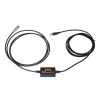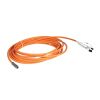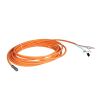Solinst Water Level Temperature Sensors
Features
- Vented or absolute pressure sensor options with 0.05% full scale accuracy
- SDI-12, RS-485 Modbus RTU, and 4-20mA protocols for interfacing with data loggers and PLC systems
- Built-in hydrophobic filters eliminate the need for desiccant replacement on vented sensors
- Free ground shipping
- Expedited repair and warranty service
- Lifetime technical support
- More
Overview
The Solinst Water Level Temperature Sensor is a compact, all-in-one submersible hydrostatic level transmitter that provides continuous, stable and accurate water level and temperature readings for a wide variety of applications. The water level pressure sensor and temperature sensor are enclosed in a slim, robust 22 mm x 192 mm (7/8" x 7.55") 316L stainless steel housing. Double O-ring seals prevent leaks, and a Faraday cage design protects against power surges and lightning.
Design
Each probe features a removable nose cone for optional use of the 1/4" NPTM threaded connection. The durable water level pressure sensor provides 0.05% FS accuracy with automatic temperature-compensated readings. There are six pressure ranges to choose from (5-200 m), with options for absolute (non-vented) and gauged (vented) pressure sensor setups.
Data Availability
The Water Level Temperature Sensor works with digital and analog protocols – MODBUS, SDI-12, and 4-20mA (add-on Current Loop Adaptor). They are easy to integrate into existing SCADA or PLC systems. Communication cable assemblies are available in lengths up to 300 meters. The cables are easily and securely attached to the sensor using a threaded connection. Simple PC software utilities are used to set up the sensor for the different protocols, perform simple diagnostics, and update sensor firmware if required. A USB-A programming cable is available for connection to the PC.
In The News
Solinst Model 301 WLTS: Works Well Under Pressure
From an already successful line of water level and temperature loggers comes the new Water Level Temperature Sensor (WLTS) by Solinst, Inc. Unlike other water level measurement devices offered by Solinst, the WLTS is designed to integrate with 3rd party data loggers in industrial and environmental monitoring systems using digital communication protocols. Sensors that can be easily integrated with external devices allow for the addition of stable and continuous water level and temperature measurements to existing monitoring networks. While some water level sensors use pressure transducers to determine water level, the WLTS utilizes a hydrostatic level transmitter to record water levels and a platinum resistance temperature detector for temperature compensation.
Read MoreSupplying Seattle’s Drinking Water: Using Data Buoys to Monitor the Cedar River Municipal Watershed
Providing clean, safe, and reliable drinking water for the 1.6 million people in the greater Seattle area is a top priority for Seattle Public Utilities (SPU). With limited water supplies, SPU dedicates considerable resources to maintain its watersheds and mountain reservoirs. About 70 percent of Seattle Water comes from the Cedar River Municipal Watershed , and the other 30 percent comes from the South Fork Tolt River Watershed . [caption id="attachment_39574" align="alignnone" width="940"] Data buoy in Chester Morse Lake. Data buoy in Masonry Pool. (Credit: Kevin Johnson / Seattle Public Utilities) [/caption] Jamie Thompson, a fisheries biologist at SPU, monitors aquatic ecosystems centered on fish listed under the U.S. Endangered Species Act (ESA).
Read MoreData-Driven Advocacy on the Lower Deschutes River
Like many freshwater environments, the Deschutes River in Oregon is under pressure from development, pollution, and climate change. Many rivers, streams and lakes in the Deschutes Basin do not meet Oregon water quality standards –where state water quality monitoring assesses levels of bacteria, pH, dissolved oxygen, temperature, and fine sediment. Hannah Camel is the Water Quality Coordinator for the Deschutes River Alliance (DRA), a non-profit organization that focuses on the health of the lower 100 miles of the Deschutes River–the area most affected by human intervention. As a data-driven organization, the DRA has benefited from the installation of two NexSens X2 data loggers.
Read More






































